The Dihydromyrcene Market is estimated to be valued at USD 322.5 million in 2025 and is projected to reach USD 664.7 million by 2035, registering a compound annual growth rate (CAGR) of 7.5% over the forecast period.
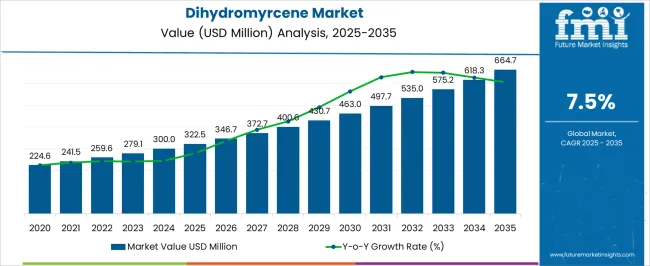
| Metric | Value |
|---|---|
| Dihydromyrcene Market Estimated Value in (2025 E) | USD 322.5 million |
| Dihydromyrcene Market Forecast Value in (2035 F) | USD 664.7 million |
| Forecast CAGR (2025 to 2035) | 7.5% |
The Dihydromyrcene market is experiencing robust growth due to its increasing use as a key intermediate in the fragrance and personal care industries. In 2025, the market is driven by the rising demand for naturally derived and high-purity chemical intermediates that ensure consistency and quality in end products. The market outlook is shaped by the growing emphasis on premium fragrances, high-quality personal care products, and stringent quality standards in cosmetics.
Expanding investments in R&D and formulation innovation in the fragrance industry are enabling the creation of novel scent profiles, where Dihydromyrcene serves as a vital building block. The ability to maintain high stability and reactivity in formulations has enhanced its adoption across multiple applications.
Additionally, increasing consumer preference for eco-friendly, safe, and high-performance personal care products has accelerated the use of Dihydromyrcene The combination of these factors, alongside improvements in production efficiency and the focus on high-purity grades, is expected to sustain market growth while opening opportunities for new applications in adjacent industries.
The dihydromyrcene market is segmented by purity, application, end use, and geographic regions. By purity, dihydromyrcene market is divided into >99% Purity and <99% Purity. In terms of application, dihydromyrcene market is classified into Dihydromyrcenol, Methoxyl citronellal, Menthol, and Other. Based on end use, dihydromyrcene market is segmented into Personal care & cosmetics, Soap & detergents, and Others. Regionally, the dihydromyrcene industry is classified into North America, Latin America, Western Europe, Eastern Europe, Balkan & Baltic Countries, Russia & Belarus, Central Asia, East Asia, South Asia & Pacific, and the Middle East & Africa.
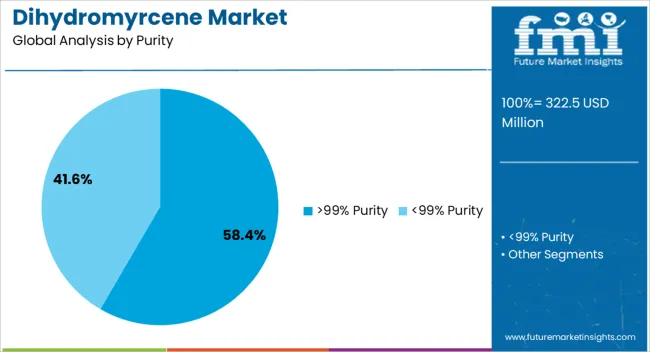
The >99% Purity segment is projected to account for 58.40% of the Dihydromyrcene market revenue share in 2025, positioning it as the leading segment in terms of purity. This dominance is being driven by its critical role in achieving high-quality, consistent performance in downstream fragrance and personal care formulations. High-purity Dihydromyrcene is preferred by manufacturers to ensure precise olfactory characteristics, stability under processing conditions, and reduced risk of undesired reactions in formulations.
The segment has benefitted from stringent industry standards and regulatory guidelines requiring pure intermediates for cosmetic and personal care applications. Adoption has been further supported by manufacturers’ focus on premium products and the need to meet consumer expectations for long-lasting and high-performing fragrances.
The flexibility to integrate high-purity Dihydromyrcene in multiple formulations without compromising quality has also reinforced its market leadership As demand for sophisticated fragrance profiles continues to grow, the >99% Purity segment is expected to maintain its leading position, driven by quality assurance and performance reliability.
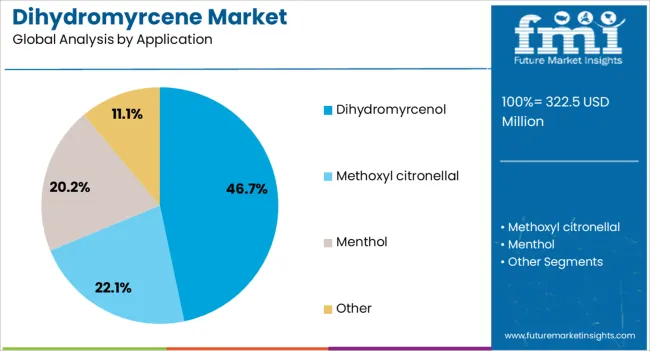
The Dihydromyrcenol application segment is estimated to hold 46.70% of the market revenue share in 2025, establishing it as the largest application area for Dihydromyrcene. This prominence is being attributed to its versatile use in producing high-value fragrance compounds that provide fresh and appealing olfactory characteristics. Growth in this segment has been reinforced by increasing consumer preference for refined scents in personal care and home fragrance products.
Dihydromyrcenol is highly valued due to its stability, ease of formulation, and compatibility with other fragrance ingredients, which enables consistent quality and reproducibility across products. The segment has been supported by expanding production capacities and improvements in process efficiency, which have enhanced the availability of this intermediate at commercial scale.
Additionally, rising investments by fragrance manufacturers in innovation and the development of premium perfumery products have further boosted adoption As trends continue toward high-quality fragrances with complex scent profiles, the Dihydromyrcenol application segment is projected to maintain a leading role in the Dihydromyrcene market.
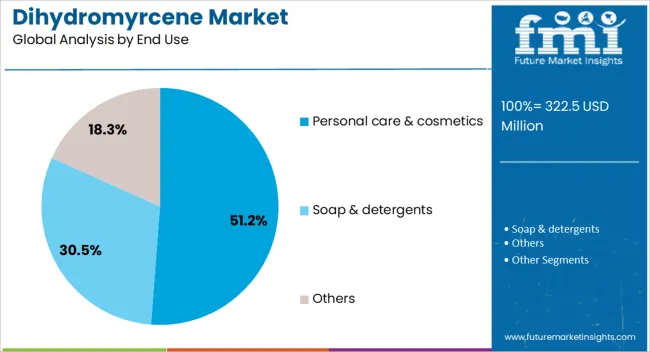
The Personal Care and Cosmetics end-use segment is anticipated to account for 51.20% of the Dihydromyrcene market revenue share in 2025, making it the dominant sector in end-use applications. This leadership is being driven by the increasing incorporation of Dihydromyrcene derivatives in perfumery, skincare, hair care, and cosmetic products to enhance fragrance, texture, and sensory appeal.
The segment has benefitted from the growing demand for premium and natural cosmetic formulations, where the consistent quality and stability of Dihydromyrcene are highly valued. Adoption has been further supported by rising disposable incomes, changing consumer preferences for high-end personal care products, and increasing investments in product innovation by leading cosmetic brands.
Moreover, regulatory emphasis on ingredient purity and safety has reinforced the use of high-quality Dihydromyrcene, particularly in formulations targeting sensitive skin The segment’s growth trajectory is expected to continue as global personal care and cosmetics markets expand, driven by urbanization, rising consumer awareness, and a preference for innovative, high-performance fragrance and cosmetic products.
Dihydromyrcene is a colorless organic compound that belongs to the acyclic terpenic alcohols family. Dihydromyrcene is the main constituent chemical used to impart fragrance to personal care and cosmetic products. Rising consumer spending on personal care & cosmetic products and increasing consumption of fragrance chemicals in detergents and soaps are the prime factors that fuel the fragrance chemical market, which in turn is expected to drive the dihydromyrcene market. Increasing urbanization, population, changing living standards and rising per capita disposable income are some of the major factors significantly affecting the dihydromyrcene market. With growing economic prosperity and increasing purchasing power, people are moving towards the use of products that were earlier unaffordable.
This, in turn, has resulted into an increase in the demand for consumer products such as personal care and cosmetics, among others. Further, significant growth in the fragrance industry provides impetus for the growth of the dihydromyrcene market. Incessant development of natural and organic fragrance products is expected to create lucrative opportunities for the growth of the dihydromyrcene market in the near future.
Generally, dihydromyrcene is used as an intermediate chemical in the production of fine fragrances such as methoxyl citronellal, jasmine fragrance, dihydromyrcenol, menthol, M.C. lactone and sandalwood, among others. Dihydromyrcene is considered as an indispensable part of perfumery products. Thus, the growing demand for perfume products across the globe is in turn expected to drive the demand for dihydromyrcene over the forecast period. In terms of demand, the personal care industry is expected to account for a significant share of the global dihydromyrcene market, followed by the soap and detergent industry.
The market for dihydromyrcene is mainly driven by innovative consumer products, especially in personal care applications such as skin care and hair care products. However, stringent government regulations in Europe and North America may hamper the growth of the dihydromyrcene market whereas Asia Pacific is expected to register lucrative growth, owing to the rising consumer spending and increasing demand for personal care products.
In terms of production and consumption, the global dihydromyrcene market is mainly dominated by the Asia Pacific region (APAC), especially China. Substantial growth in the demand for dihydromyrcene from several industries such as personal care, cosmetic and detergent, helps drive the dihydromyrcene market in Asia Pacific.
Moreover, increasing per capita disposable income and per capita spending in developing countries such as India and China has resulted in growth in the demand for dihydromyrcene. In the Asia Pacific region, India and China are the major markets for dihydromyrcene in terms of volume and volume. The Asia Pacific dihydromyrcene market is expected that register a significant CAGR over the forecast period. North America, followed by Europe, collectively holds a substantial share in the dihydromyrcene market. The increasing demand for personal care and cosmetic products in Europe and North America is expected to fuel the demand for dihydromyrcene over the forecast period.
In Europe, Germany dominates the dihydromyrcene market in terms of consumption. However, stringent government regulations in Europe and North America may affect the growth of the dihydromyrcene market. North America and Europe dihydromyrcene markets are expected to grow with significant CAGRs over the forecast period. Middle East & Africa and Latin America dihydromyrcene markets are expected to register slow growth over the forecast period.
Some of the key players identified across the value chain of the global dihydromyrcene market are:
The research report presents a comprehensive assessment of the market and contains thoughtful insights, facts, historical data, and statistically supported and industry-validated market data. It also contains projections using a suitable set of assumptions and methodologies. The research report provides analysis and information according to market segments such as geographies, application, and industry.
The report is a compilation of first-hand information, qualitative and quantitative assessment by industry analysts, inputs from industry experts and industry participants across the value chain. The report provides in-depth analysis of parent market trends, macro-economic indicators and governing factors along with market attractiveness as per segments. The report also maps the qualitative impact of various market factors on market segments and geographies.
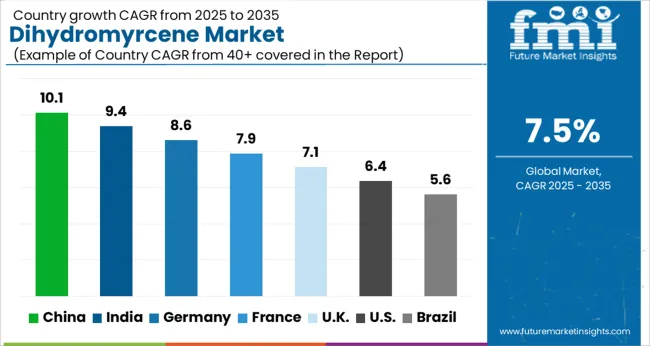
| Country | CAGR |
|---|---|
| China | 10.1% |
| India | 9.4% |
| Germany | 8.6% |
| France | 7.9% |
| UK | 7.1% |
| USA | 6.4% |
| Brazil | 5.6% |
The Dihydromyrcene Market is expected to register a CAGR of 7.5% during the forecast period, exhibiting varied country level momentum. China leads with the highest CAGR of 11.5%, followed by India at 10.6%. Developed markets such as Germany, France, and the UK continue to expand steadily, while the USA is likely to grow at consistent rates. Brazil posts the lowest CAGR at 5.6%, yet still underscores a broadly positive trajectory for the global Dihydromyrcene Market. In 2024, Germany held a dominant revenue in the Western Europe market and is expected to grow with a CAGR of 8.6%. The USA Dihydromyrcene Market is estimated to be valued at USD 109.8 million in 2025 and is anticipated to reach a valuation of USD 203.7 million by 2035. Sales are projected to rise at a CAGR of 6.4% over the forecast period between 2025 and 2035. While Japan and South Korea markets are estimated to be valued at USD 15.4 million and USD 9.7 million respectively in 2025.
| Item | Value |
|---|---|
| Quantitative Units | USD 322.5 Million |
| Purity | >99% Purity and <99% Purity |
| Application | Dihydromyrcenol, Methoxyl citronellal, Menthol, and Other |
| End Use | Personal care & cosmetics, Soap & detergents, and Others |
| Regions Covered | North America, Europe, Asia-Pacific, Latin America, Middle East & Africa |
| Country Covered | United States, Canada, Germany, France, United Kingdom, China, Japan, India, Brazil, South Africa |
| Key Companies Profiled | Ernesto Ventós, Sky Dragon Fine-Chem, EcoGreen, Xinhua Chemical, and Privi Organics India Limited |
The global dihydromyrcene market is estimated to be valued at USD 322.5 million in 2025.
The market size for the dihydromyrcene market is projected to reach USD 664.7 million by 2035.
The dihydromyrcene market is expected to grow at a 7.5% CAGR between 2025 and 2035.
The key product types in dihydromyrcene market are >99% purity and <99% purity.
In terms of application, dihydromyrcenol segment to command 46.7% share in the dihydromyrcene market in 2025.






Full Research Suite comprises of:
Market outlook & trends analysis
Interviews & case studies
Strategic recommendations
Vendor profiles & capabilities analysis
5-year forecasts
8 regions and 60+ country-level data splits
Market segment data splits
12 months of continuous data updates
DELIVERED AS:
PDF EXCEL ONLINE

Thank you!
You will receive an email from our Business Development Manager. Please be sure to check your SPAM/JUNK folder too.
Chat With
MaRIA